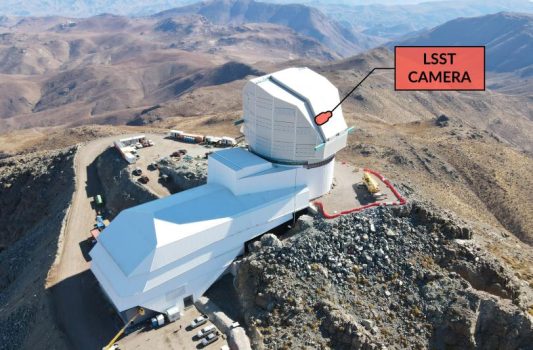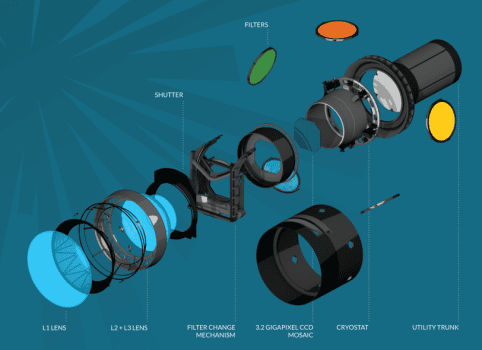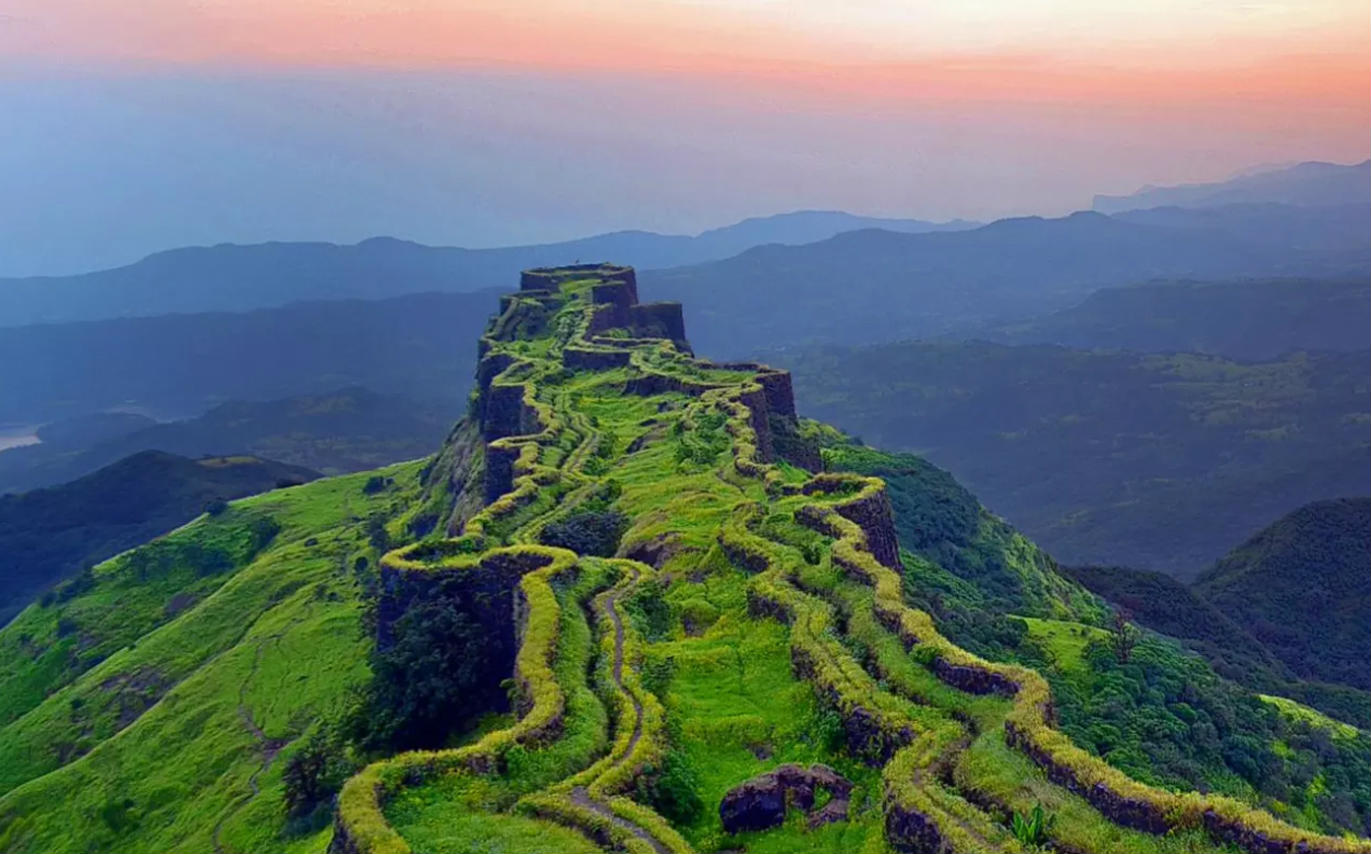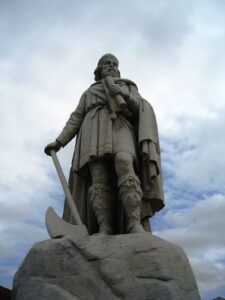 Pin
Pin The camera will be mounted on the Simonyi Survey Telescope at the Rubin Observatory, located high in Chile’s Andes Mountains. (Rubin Observatory – National Science Foundation – AURA)
In the near-pristine skies of Cerro Pachón, Chile, a camera the size of a small car redefines what’s possible in imaging. This monumental device, known as the Vera C. Rubin Observatory’s LSST camera, boasts an astounding 3,200 megapixels. Imagine every snap spanning seven full moons and sharp enough to resolve a golf ball from 25 km away—everything about this camera is engineered to astonish.
Its massive 2.8‑ton body packs 189 custom CCD sensors tiled across a flat focal plane more than half a metre wide. The front lens alone measures about 1.65 m in diameter—the largest ever made for a digital camera. Housed within a cryostat at –148 °F, it stays stable and dew‑free as it captures the faintest glimmers in our universe.
Beyond its sheer size, this camera dazzles with capability: capturing 20 terabytes each night, surveying 40 billion celestial objects over its ten‑year mission. It’s not just a marvel of engineering—it is the eyes of a cosmic time‑lapse, ready to reveal the universe’s deepest mysteries.
Table of Contents
Behind the Scenes: Crafting an Engineering Marvel
 Pin
Pin The front view of the fully assembled LSST Camera reveals its 3,200-megapixel focal plane inside. (Jacqueline Ramseyer Orrell – SLAC National Accelerator Laboratory)
Taking two decades of planning and execution, assembling this technical masterpiece demanded international collaboration. Built at SLAC National Accelerator Laboratory and supported by Brookhaven, Lawrence Livermore, CNRS‑IN2P3, and more, the project harnessed some of the world’s most advanced optics and sensors. The camera’s colossal body—roughly 3 m long and 1.65 m tall at about 2,800 kg—houses a flat, 64 cm-wide focal plane. Within, 189 CCDs across 21 “rafts” create a combined 3.2 gigapixels, each pixel just 10 μm across. These sensors are so precisely aligned that their plane varies by less than one‑tenth the width of a human hair.
The camera’s lenses are feats on their own. Its front glass measures 1.57 m in diameter—the largest ever fabricated for a digital camera—supported by a three‑lens optical corrector that ensures sharp images across a vast 3.5° field. To capture fleeting cosmic events, every exposure lasts just 15 s, with a 20 s cadence. A robotic filter changer holds six heavy filters, swapping them in under two minutes.
A Telescope with a Story and a Future
 Pin
Pin A visual illustration of the LSST Camera highlights its key parts such as the lenses, sensor array, and utility trunk. (Chris Smith – SLAC National Accelerator Laboratory)
By early March 2025, after meticulous planning, engineers finally positioned the LSST camera atop the 8.4 m Simonyi Survey Telescope on Cerro Pachón. It was a moment decades in the making—two teams mounting a 3+ ton instrument the size of a small SUV, balancing it with millimetre precision. This installation marked Rubin Observatory’s entry into the final testing phase ahead of its grand unveiling later in the year.
Soon this marvel will regularly scan the southern skies—capturing a snapshot every 15 seconds, yielding over 800 full-field images per night. That amounts to 20 TB of data nightly, culminating in an archive of tens of petabytes over its 10‑year mission. This torrent of information will fuel global research—from tracking near‑Earth asteroids to mapping dark matter through weak gravitational lensing.
Chile’s clear skies and nearly 260 cloudless nights annually make this desert peak one of the world’s best platforms. Together with rapid robotic scheduling and AI-driven target decisions, this observatory will continuously adapt and react—revealing supernovae, transient flares, and even faint dwarf galaxies almost as soon as they appear.
The Dawn of First Light and a Time‑Lapse of the Cosmos
In mid‑2025, after weeks of careful hookup and alignment, the world’s largest digital camera began collecting genuine sky images above Chile’s Cerro Pachón. April 15, the team powered it up and captured initial test shots using its i‑band filter; around 183 of the 189 CCD sensors were active, delivering crisp 1.8‑arcsec resolution even before full optimization. Soon after, engineers confirmed the data pipeline could read and process each 3‑gigapixel frame in under a minute—an achievement on par with its sheer image size.
Looking ahead, Rubin Observatory prepares to make its “First Look” presentation in June 2025. This event will unveil stunning telescope-captured scenes to the public and mark the launch of its Legacy Survey of Space and Time (LSST). Over a decade, it will generate roughly 20 TB nightly—each snapshot covering a sky area equivalent to 40–50 full moons—forming an unprecedented cosmic movie.
This deep, fast, wide-field survey will track transient events: exploding stars, near‑Earth asteroids, flares, and even signs of cosmic anomalies, rewriting our map of the dynamic universe.
The Countdown to First Look: June 23, 2025
On June 23, 2025, at 11 a.m. EDT (3 p.m. UTC), the First Look event will unveil the very first images captured by the world’s most impressive digital sensor. Hosted by NSF and DOE, this momentous livestream marks the camera’s debut and begins a revolutionary era in astronomy. Watch parties will take place worldwide—in universities, planetariums, and even public plazas—to share in this historic reveal.
The images will showcase the LSST’s extraordinary field of view and resolution, capturing a sky area equivalent to several moons with clarity fine enough to resolve minute cosmic features. Within seconds, viewers worldwide will witness a visual feast: galaxies, star clusters, and perhaps new supernovae. Scientific teams will immediately begin analyzing these test images, used to refine the camera’s performance before the main ten-year Legacy Survey of Space and Time starts.
This First Look launch is not just about visuals—it sets into motion a continuous flow of roughly 20 TB of nightly data, creating an ultra-high-definition movie of the cosmos. Beyond awe, it’s a signal of expanding human curiosity and the promise of scientific breakthroughs yet unseen.
A New Dawn for Astronomy: What Comes Next
As the dust settles from the First Look event on June 23, 2025 at 11 a.m. EDT—broadcast live from Cerro Pachón and celebrated worldwide—the scientific adventure truly begins. This landmark day marks the largest digital camera’s entry into operational life, transitioning from testing to the Legacy Survey of Space and Time (LSST). No longer just a marvel of engineering, it becomes the tool that stitches together humanity’s most detailed, dynamic map of the southern sky.
Night after night, the observatory will systematically scan the heavens with unmatched speed and fidelity. Every 15‑second exposure—collected every 20 seconds—adds to a torrent of data (roughly 20 TB nightly) that chronicles cosmic events in real time. Whether tracking near‑Earth objects, capturing supernovae explosions, or mapping dark matter, each frame brings us closer to understanding the universe’s most elusive phenomena.
Ground-based data centres and cloud networks around the globe are already preparing for the influx, ready with advanced AI pipelines that will sort, analyse, and alert researchers in seconds. In the years ahead, the world will follow a new cosmic movie from night to night—revealing how galaxies evolve, how dark matter weaves through space, and how the transient sky writes new chapters in the story of existence.
Data in Motion: Pipelines, Platforms & the Nightly Deluge
Every night, as the Vera C. Rubin Observatory’s Largest digital camera sweeps the skies, it pours roughly 20 TB of raw data down a Chilean mountaintop via fiber optics at nearly 600 Gb/s. On-site, prompt pipelines process exposures within 60 seconds, generating calibrated images and alerts for transient events like supernovae or moving asteroids. These lightning‑fast alerts help scientists worldwide track sudden cosmic occurrences almost as they happen.
Once transferred to regional data centers—including facilities in the U.S. and France—the images enter deeper processing. Here, nightly data are stacked into “Single‑Visit” calibrated frames, then annually re‑processed into deep co-added images and catalogs spanning billions of stars and galaxies. This workflow relies on the open-source LSST Science Pipelines—the same sophisticated software stack built for scale, automation, and high‑performance execution in clouds like AWS and GCP, or on-prem clusters.
All products—images, object catalogs, alert streams—are accessible through the Rubin Science Platform and show how smart infrastructure meets raw astrophysical ambition. As operations gear up for full survey mode, these pipelines will underpin our ability to query, visualize, and mine this cosmic dataset at planetary scale.
A Global Collaboration Behind the Cosmic Eye
Behind the engineering marvel of the world’s largest digital camera lies a global network of brilliant minds and institutions. This camera wasn’t built in isolation; it’s the result of two decades of international collaboration between U.S. national labs, European research institutes, and private contractors . From lens manufacturing in Arizona to CCD sensor development at Brookhaven and final assembly at SLAC, each piece of this giant puzzle crossed continents before coming together on a Chilean mountaintop.
The Vera C. Rubin Observatory is funded jointly by the National Science Foundation (NSF) and the Department of Energy (DOE), with critical support from institutions like CNRS (France), IN2P3, and universities worldwide. Thousands of scientists are already signed on to access its data through the Rubin Science Platform—an online research suite offering direct access to catalogs, alerts, and image stacks .
This isn’t just a U.S. telescope—it’s Earth’s telescope, scanning the universe for everyone. Its discoveries will benefit all of humanity, from understanding dark energy to protecting our planet from near-Earth asteroids. It’s a shared mission, driven by curiosity and unity across borders.
Dark Energy, Asteroids & the Unseen Universe
At the heart of the Rubin Observatory’s mission lies one of science’s greatest puzzles: dark energy. Using the enormous reach of its 3.2‑gigapixel camera, researchers will measure how galaxies move and spread out across time. These patterns could offer powerful clues about the mysterious force believed to be accelerating the universe’s expansion . Unlike previous telescopes that focused on narrow patches, this camera’s wide field of view allows it to track billions of galaxies—helping to unlock cosmic behavior on a grand scale.
Beyond dark energy, it will also revolutionize how we track near-Earth objects. With its rapid scan speed and wide field, the system can detect asteroids and comets that might pose risks—long before they come dangerously close . This opens the door to early-warning systems powered by deep sky data, not just guesswork.
Perhaps even more exciting are the discoveries scientists can’t predict. The observatory’s high-cadence monitoring of the entire southern sky means it’s likely to capture never-before-seen cosmic events—those fleeting, rare moments that help redefine our understanding of time, matter, and space itself.
A Legacy Etched in Light and Time
As the Vera C. Rubin Observatory begins full operations, it doesn’t just mark a technological milestone—it initiates a cultural and scientific legacy that will span generations. The telescope and its largest digital camera are not just tools for today’s discoveries but archives for tomorrow’s questions. Over ten years, its images will create the most detailed cinematic map of the sky ever compiled—accessible to scientists, educators, students, and curious minds across the globe.
Each exposure taken will be stored, cataloged, and publicly released in annual data sets, fueling countless PhDs, published papers, and even high school science fair projects. Its impact won’t be limited to astronomy—it will ripple through data science, AI, education, and public outreach. Already, initiatives are in place to bring these discoveries to underserved classrooms and citizen science platforms where anyone can participate.
Long after the final image is snapped, the Vera Rubin Observatory will remain a symbol of what science can achieve: when humanity dares to look up, ask big questions, and build something extraordinary to find the answers—frame by cosmic frame.
FAQs
The camera at the Vera C. Rubin Observatory holds the record as the largest digital camera ever built due to its massive 3,200-megapixel sensor, a 64 cm-wide focal plane, and a front lens over 1.5 meters in diameter. It’s designed to capture wide, high-resolution images of the night sky, producing around 20 terabytes of data every night.
This camera is the centerpiece of the Legacy Survey of Space and Time (LSST), which will map the southern sky in unprecedented detail. It will track galaxies, monitor supernovae, detect near-Earth asteroids, and gather data to study dark matter and dark energy over a ten-year mission.
The camera is mounted on the Simonyi Survey Telescope at the Vera C. Rubin Observatory, located on Cerro Pachón in northern Chile. This site was chosen for its high altitude, clear skies, and low light pollution.
Each exposure takes only 15 seconds, and the system can take a new image every 20 seconds. This high-speed cadence allows the observatory to survey the entire southern sky roughly twice each week, capturing dynamic and fleeting cosmic events.
Yes. The Rubin Observatory is committed to open science. Images and data will be released annually to the public through the Rubin Science Platform, and selected highlights will be shared more frequently via public outreach and education programs.





























